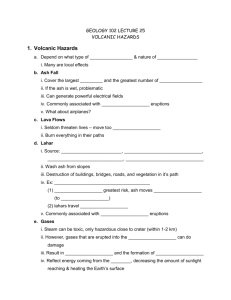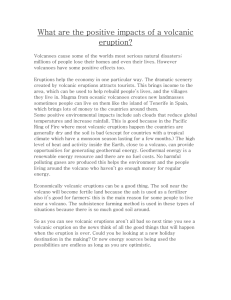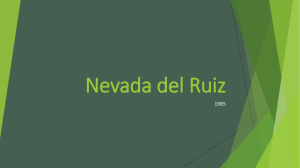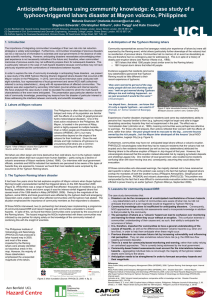Where humans live in close proximity to volcanoes there is a risk of
advertisement
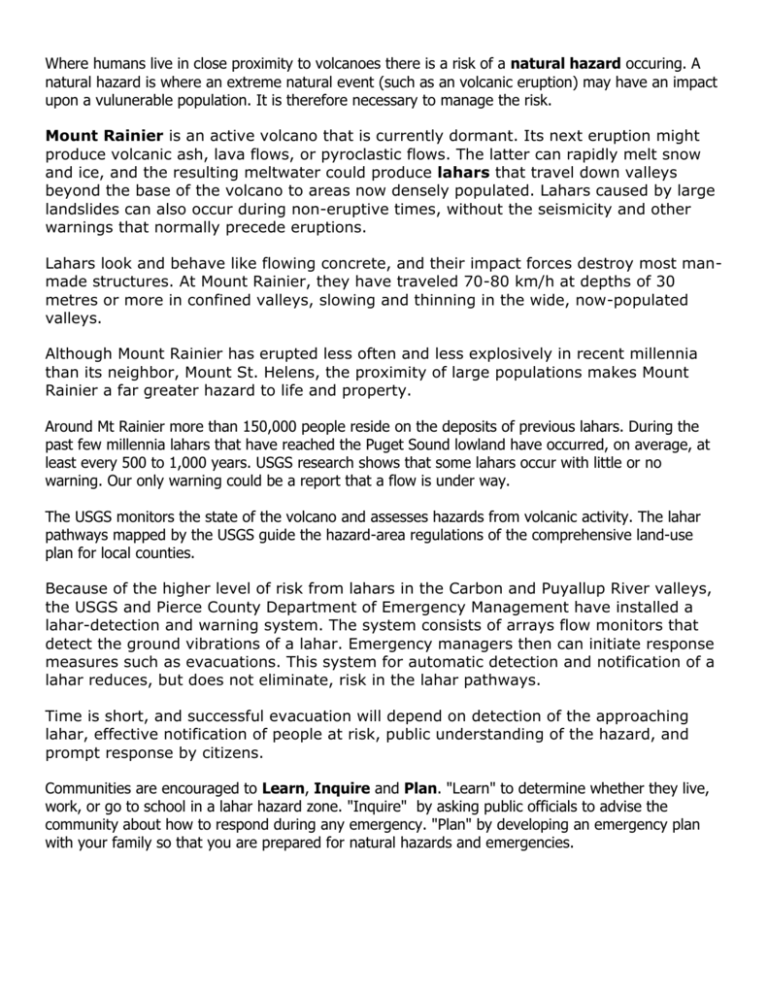
Where humans live in close proximity to volcanoes there is a risk of a natural hazard occuring. A natural hazard is where an extreme natural event (such as an volcanic eruption) may have an impact upon a vulunerable population. It is therefore necessary to manage the risk. Mount Rainier is an active volcano that is currently dormant. Its next eruption might produce volcanic ash, lava flows, or pyroclastic flows. The latter can rapidly melt snow and ice, and the resulting meltwater could produce lahars that travel down valleys beyond the base of the volcano to areas now densely populated. Lahars caused by large landslides can also occur during non-eruptive times, without the seismicity and other warnings that normally precede eruptions. Lahars look and behave like flowing concrete, and their impact forces destroy most manmade structures. At Mount Rainier, they have traveled 70-80 km/h at depths of 30 metres or more in confined valleys, slowing and thinning in the wide, now-populated valleys. Although Mount Rainier has erupted less often and less explosively in recent millennia than its neighbor, Mount St. Helens, the proximity of large populations makes Mount Rainier a far greater hazard to life and property. Around Mt Rainier more than 150,000 people reside on the deposits of previous lahars. During the past few millennia lahars that have reached the Puget Sound lowland have occurred, on average, at least every 500 to 1,000 years. USGS research shows that some lahars occur with little or no warning. Our only warning could be a report that a flow is under way. The USGS monitors the state of the volcano and assesses hazards from volcanic activity. The lahar pathways mapped by the USGS guide the hazard-area regulations of the comprehensive land-use plan for local counties. Because of the higher level of risk from lahars in the Carbon and Puyallup River valleys, the USGS and Pierce County Department of Emergency Management have installed a lahar-detection and warning system. The system consists of arrays flow monitors that detect the ground vibrations of a lahar. Emergency managers then can initiate response measures such as evacuations. This system for automatic detection and notification of a lahar reduces, but does not eliminate, risk in the lahar pathways. Time is short, and successful evacuation will depend on detection of the approaching lahar, effective notification of people at risk, public understanding of the hazard, and prompt response by citizens. Communities are encouraged to Learn, Inquire and Plan. "Learn" to determine whether they live, work, or go to school in a lahar hazard zone. "Inquire" by asking public officials to advise the community about how to respond during any emergency. "Plan" by developing an emergency plan with your family so that you are prepared for natural hazards and emergencies. What to do Before a Volcanic Eruption Add a pair of goggles and disposable breathing mask for each member of the family to your disaster supply kit. Stay away from active volcano sites. If you live near a known volcano, active or dormant, be ready to evacuate at a moment's notice. What to Do During a Volcanic Eruption Follow the evacuation order issued by authorities and evacuate immediately from the volcano area to avoid flying debris, hot gases, lateral blast, and lava flow. Be aware of mudflows. The danger from a mudflow increases near stream channels and with prolonged heavy rains. Mudflows can move faster than you can walk or run. Look upstream before crossing a bridge, and do not cross the bridge if a mudflow is approaching. Avoid river valleys and low-lying areas. Remember to help your neighbors who may require special assistance - infants, elderly people, and people with disabilities. Listen to a battery-powered radio or television for the latest emergency information. If you have a respiratory ailment, avoid contact with any amount of ash. Wear long-sleeved shirts and long pants. Use goggles and wear eyeglasses instead of contact lenses. Use a dust mask or hold a damp cloth over your face to help with breathing. Stay away from areas downwind from the volcano to avoid volcanic ash. Stay indoors until the ash has settled unless there is a danger of the roof collapsing. Close doors, windows, and all ventilation in the house (chimney vents, furnaces, air conditioners, fans, and other vents. Clear heavy ash from flat or low-pitched roofs and rain gutters. Avoid running car or truck engines. Driving can stir up volcanic ash that can clog engines, damage moving parts, and stall vehicles. Avoid driving in heavy ash fall unless absolutely required. If you have to drive, keep speed down to 35 mph or slower. Volcanic Hazard management 1. 2. 3. 4. Describe the location of Mt Rainer List 4 volcanic hazards associated with Mt Rainer What is a Lahar? Using the Map of lahar flows around Mt Rainer: Describe and explain the pattern of volcanic hazards associated with Mt Rainer 5. Explain 3 ways in which the volcanic hazards around Mt Rainer are managed in the area surrounding the volcano. 6. Using the information from FEMA produce a poster for people in the Mt Rainer area to explain to them what to do during an earthquake Hazard.
